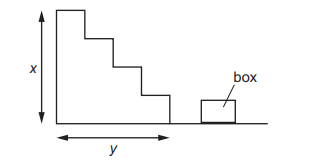Question
A horizontal force pulls a box along a horizontal surface.
The box gains 30 J of kinetic energy and 10 J of thermal energy is produced by the friction between the box and the surface.
How much work is done by the force?
A 10 J
B 20 J
C 30 J
D 40 J
Answer/Explanation
Ans: D
Question
Which situation involves no work being done and no energy being transferred?
a car skidding to a stop on a road
a crane lifting a load
a heavy load hanging from a strong bar
a student dragging a big box over a rough floor
Answer/Explanation
Ans: C
Question
A box of mass m and weight W is carried up some stairs of total height x and total width y.

On which quantities does the work done against gravity on the box depend?
A m and y B W and x C W and y D x and y
Answer/Explanation
Ans: B
Question
Student P uses a force of 35 N to push a box 3.0 m across the floor.
Student Q uses a force of 22 N to push another box 1.8 m across the floor.
Which statement gives a full explanation why student P uses more energy than student Q?
Student P pushes his box a greater distance than student Q.
Student P pushes his box a greater distance and uses a bigger force than student Q.
Student P uses a bigger force than student Q.
Student P pushes a heavier box than student Q.
Answer/Explanation
Ans: B
Question
A man pulls a truck a distance of 20 m, as shown in the three diagrams.

Which statement concerning the work done against gravity is correct?
Most work is done in 1.
No work is done in 3.
The work done in all three is equal.
The work done in 1 and 2 is equal.
Answer/Explanation
Ans: A
Work done against gravity depends upon the height of object through with which it displaced
In the given situations
